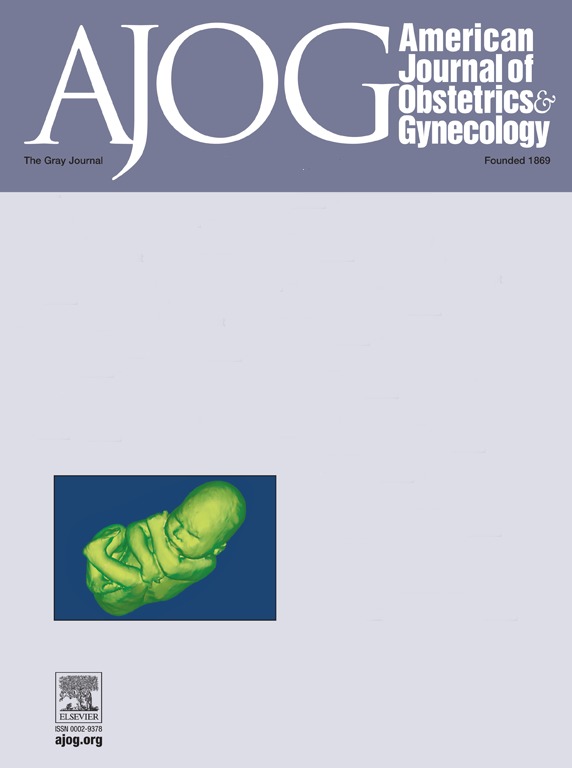Reverse Løvset maneuver for shoulder dystocia.
IF 8.7
1区 医学
Q1 OBSTETRICS & GYNECOLOGY
引用次数: 0
Abstract
Shoulder dystocia is an obstetric emergency associated with fetal morbidity and mortality. Mechanical obstruction and failure of the rotation of the fetal shoulders prevents their descent into the pelvis. Current management strategies work by increasing the relative pelvic diameters, rotating the fetal shoulders into a more favorable pelvic diameter, or by reducing the fetal biacromial diameter. We present the Reverse Løvset maneuver that was initially described in 1948, by the Norwegian obstetrician Jørgen Løvset. It is a powerful internal rotational maneuver that differs from the more widely known maneuvers. It allows for a higher rotational force onto the fetus without increasing the strain on the brachial plexus, fetal long bones or the perineum. The clinician needs to use the hand of which the palm faces the fetal back. The whole hand is inserted into the vagina at the 6 o'clock position and continues along the fetal back until it reaches the posterior axilla. The index and middle fingers then grip the posterior axillary fold in a hook-like grip, avoiding the axillary fossa. The other hand fixates the wrist of the operating hand. As the clinician rotates their upper body away from the arm holding the fetal torso, while holding the operating wrist, elbow and shoulder stable, a rotational force is transferred to the fetal body. The posterior shoulder is rotated so that the fetus moves towards a "belly down" position, simultaneously dislodging the anterior shoulder from behind the maternal symphysis. This "cork screw" like rotation is continued up to 180 degrees until descent of the fetal body is felt. An effective transmission of the rotational force is achieved by the correct grip on the muscularly prominent posterior axillary fold adjacent to the strong and relatively stiff posterior thorax of the fetus.反向Løvset手法治疗肩难产。
肩难产是一种与胎儿发病率和死亡率相关的产科急诊。机械性的阻塞和胎儿肩部旋转的失败阻止了它们进入骨盆。目前的治疗策略是增加骨盆的相对直径,将胎儿的肩膀旋转成更有利的骨盆直径,或者减少胎儿的双峰直径。我们介绍了由挪威产科医生Jørgen Løvset于1948年首次描述的反向Løvset手法。这是一个强大的内部旋转机动,不同于更广为人知的机动。它允许对胎儿施加更大的旋转力,而不会增加对臂丛、胎儿长骨或会阴的压力。临床医生需要用手掌朝向胎儿背部的手。整只手在6点钟位置插入阴道,沿着胎儿背部继续,直到到达后腋窝。然后食指和中指以钩状握紧后腋窝褶,避开腋窝窝。另一只手固定操作手的手腕。当临床医生旋转上半身远离抱着胎儿躯干的手臂,同时保持操作手腕、肘部和肩部稳定时,旋转力传递到胎儿身体。后肩旋转,使胎儿朝下移动,同时将前肩从母体联合后面移出。这种像“软木螺旋”一样的旋转持续到180度,直到感觉到胎儿身体的下降。旋转力的有效传递是通过正确地抓住肌肉突出的后腋窝褶皱来实现的,该褶皱与胎儿强壮而相对僵硬的后胸腔相邻。
本文章由计算机程序翻译,如有差异,请以英文原文为准。
求助全文
约1分钟内获得全文
求助全文
来源期刊
CiteScore
15.90
自引率
7.10%
发文量
2237
审稿时长
47 days
期刊介绍:
The American Journal of Obstetrics and Gynecology, known as "The Gray Journal," covers the entire spectrum of Obstetrics and Gynecology. It aims to publish original research (clinical and translational), reviews, opinions, video clips, podcasts, and interviews that contribute to understanding health and disease and have the potential to impact the practice of women's healthcare.
Focus Areas:
Diagnosis, Treatment, Prediction, and Prevention: The journal focuses on research related to the diagnosis, treatment, prediction, and prevention of obstetrical and gynecological disorders.
Biology of Reproduction: AJOG publishes work on the biology of reproduction, including studies on reproductive physiology and mechanisms of obstetrical and gynecological diseases.
Content Types:
Original Research: Clinical and translational research articles.
Reviews: Comprehensive reviews providing insights into various aspects of obstetrics and gynecology.
Opinions: Perspectives and opinions on important topics in the field.
Multimedia Content: Video clips, podcasts, and interviews.
Peer Review Process:
All submissions undergo a rigorous peer review process to ensure quality and relevance to the field of obstetrics and gynecology.

 求助内容:
求助内容: 应助结果提醒方式:
应助结果提醒方式:


